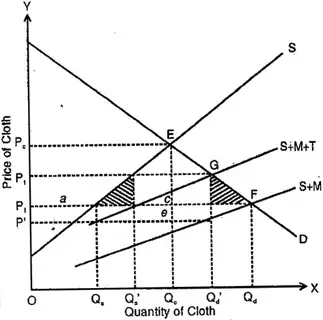Explain the Effect of a Tariff for a Large Country.
Effect of a Tariff for a Large Country:
A large country is a country large enough so that changes in its consumption of cloth can affect the world price of cloth. In case of a large country, changes in the quantity imported influence the world price of the product. Following figure illustrates the effect of a tariff in a large country:

In this diagram, domestic supply of cloth is represented by S and domestic demand for cloth is represented by D. Under autarky, equilibrium will be at E with the price of cloth being Pc.Under conditions of free trade, the country would have a total supply of cloth composed of domestic production and imports (S+M). This total supply curve S+M slopes upward because the foreign supply is not constant.
Rather, the price depends on the quantity of cloth the country buys. With free trade, the country would reach an equilibrium at point F. The price declines from Pc to Pf and the quantity of cloth that consumers are willing to buy increases from Qc to Qd.
In addition, domestic production under free trade declines from Qc to Qs as the price of cloth falls and cloth imports expand to fill the gap from Qs to Qd. If the country imposes a tariff—T—on imported cloth. The total supply curve will shift from (S+M) to (S+M+T). As a result, equilibrium changes from F to G. The price of cloth increases from Pf to Pt. As a result consumer surplus falls by areas “a+b+c+d”.
Area “a” represents the redistribution of consumer surplus to producer surplus and area “b” + “d” represents the dead weight loss.
The total government revenue collected from the tariff is equal to the areas “c” + “e”. “e” represents a redistribution of income from the foreign country to the concerned country and improves the welfare of the concerned country at the expense of foreign country.
In case of a large country, the welfare effects of a tariff are as under:
- The loss of consumers surplus = area”b” + “d’.
- Gain of welfare through terms of trade affect = area “e”.
As a result, one of the following cases can occur:
- The concerned country could find that its total welfare has decreased if area “b” + “d” is more than area “e”.
- The concerned country could find that its total welfare has remained constant if areas “b” + “d” is more than area “e”.
- The concerned country could find that is total welfare has increased if area “b” +”d” is less than area “e”.
The concerned country increases its welfare at the expenses of the foreign country’s welfare.


